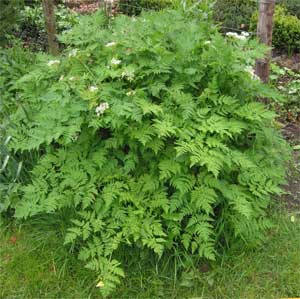Owing to the screen size of your device, you may obtain a better viewing experience by
rotating your device a quarter-turn (to get the so-called "panorama" screen view).
|
This page updated for 2022.
|
Click here for the site directory.
|
|
Please consider linking to this site!
|
Click here to email us.
|
Chervil
(Anthriscus cerefolium)
About Chervil

Francophiles regard chervil as the foremost of the five so-called fine herbes, but it has to be absolutely fresh to have any material taste at all—the supermarket stuff is utterly purposeless. It’s used much as serious cooks use parsley, but has a more delicate flavor, with a hint of anise to it (perhaps like a rather mild tarragon).
Cultivars
It is customary to snoot flat-leaf chervils for the curly-leafed types, but most sources, when push comes to shove, will concede that there is no flavor difference, just eyeball appeal. (In fact, at least one source prefers flat-leafed, claiming that curly is sometimes a trifle bitter.)
Most offerings are unnamed, just described as “chervil”; but the named varieties Brussels Winter and Vertissimo, marketed as slower to bolt than most (the plant ordinarily does not take well to warm seasons), are both reasonably available, and one of those would be our choice.
Planting
Chervil is best not sown in spring, as it becomes bland, bitter, and tough in hot weather. When sown July to mid August, it crops for a long time through autumn; or sow mid-August to early September for growing under cover through winter, till it flowers in early May.
Despite having a long taproot when planted in-ground, chervil grows well in pots: all it needs is moderately rich soil, moisture, good drainage, and a sunny situation. It is an annual that bolts easily, so it is probably wise to start a new plant often, say every 2 to 3 weeks (chervil matures fairly quickly).
If you are considering growing it in the ground rather than potted, be very careful: a close cousin of it, “wild chervil” (A. sylvestris can notoriously become a highly invasive weed and almost impossible to eradicate. That is not necessarily true of the herb species, but it may well be. Think first, then think second, before proceeding. (But invasive plants can be contained with forethought, as with mint and its relatives.)
Scatter a few seeds on the soil surface, leaving them uncovered (or perhaps under a trace of sifted soil), keep the soil moist, and wait. It typically takes about 6 to 8 weeks to be ready for cutting. (If planting outfoors, direct-seed where you want it, because chervil does not take to being transplanted.)
Note that chervil seed has a life expectancy of a year or so at most: don’t try to save leftovers from season to season.
Growing
Chervil wants to be quite well-watered, and dislikes being hot or even really warm.
Chervil notoriously bolts quickly, especially in the warmer months; keep its leaves pinched to prevent the small, white flowers from developing (and subsequently forming seeds).
Do not cook it any more than you have to. In dishes wanting chervil, it is best added at the last moment, with just enough time to get warm.
Relevant Links
Besides any links presented above on this page, the following ought to be especially helpful.
Return to the top of this page.
If you find this site interesting or useful, please link to it on your site by cutting and pasting this HTML:
The <a href="https://growingtaste.com/"><b>Growing Taste</b></a> Vegetable-Gardening Site
—Site Directory—
Search this site, or the web
-
Background Information
about the purposes and design of this site
- Site Front Page
-
Introduction

- An Apologia: why one should cultivate one's garden
- Deep-Bed Gardening (forthcoming)
- Container Gardening (forthcoming)
- Vegetarian and Organic Considerations (forthcoming)
-
Recommended Crops for a home garden, by variety
-
Gardening information and aids
-
Miscellaneous Information of interest to the home gardener
Since you're growing your own vegetables and fruits, shouldn't you be cooking them in the best way possible?
Visit The Induction Site to find out what that best way is!
|
If you like good-tasting food, perhaps you are interested in good-tasting wines as well?
Visit That Useful Wine Site for advice and recommendations for both novices and experts.
|

|
This site is one of The Owlcroft Company family of web sites. Please click on the link (or the owl)
to see a menu of our other diverse user-friendly, helpful sites.
|
|
 Like all our sites, this one is hosted at the highly regarded Pair Networks,
whom we strongly recommend. We invite you to click on the Pair link for more information on getting your site or sites hosted on a first-class service.
Like all our sites, this one is hosted at the highly regarded Pair Networks,
whom we strongly recommend. We invite you to click on the Pair link for more information on getting your site or sites hosted on a first-class service.
|
|
All Owlcroft systems run on Ubuntu Linux and we heartily recommend it to everyone—click on the link for more information.
|
Click here to send us email.
Because we believe in inter-operability, we have taken the trouble to assure that
this web page is 100% compliant with the World Wide Web Consortium's
XHTML Protocol v1.0 (Transitional).
You can click on the logo below to test this page!
You loaded this page on
Wednesday, 16 April 2025, at 15:12 EDT.
It was last modified on Sunday, 9 January 2022, at 18:23 EST.
All content copyright ©1999 - 2025 by
The Owlcroft Company

